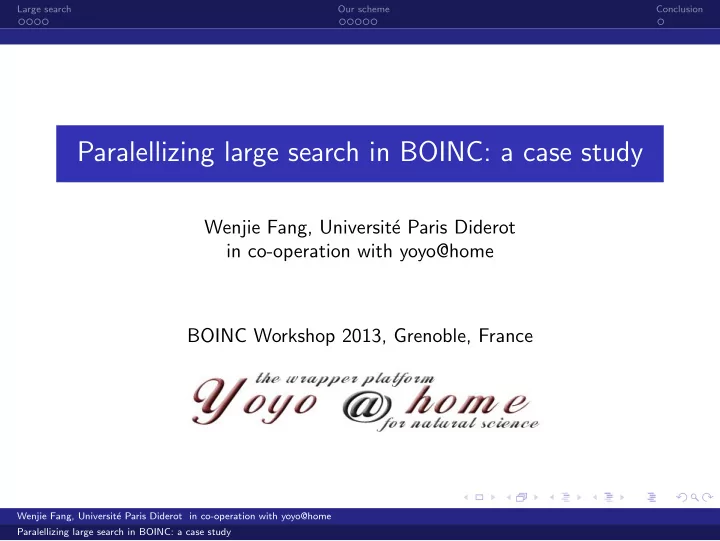

Large search Our scheme Conclusion Paralellizing large search in BOINC: a case study Wenjie Fang, Universit´ e Paris Diderot in co-operation with yoyo@home BOINC Workshop 2013, Grenoble, France Wenjie Fang, Universit´ e Paris Diderot in co-operation with yoyo@home Paralellizing large search in BOINC: a case study
Large search Our scheme Conclusion Large search Brute-force search Sometimes we just don’t have good algorithms. Satisfaction problem and constraint programming Combinatorial optimization Artificial intelligence Conjecture verification etc... Quotation When in doubt, use brute force. – Ken Thompson Wenjie Fang, Universit´ e Paris Diderot in co-operation with yoyo@home Paralellizing large search in BOINC: a case study
Large search Our scheme Conclusion Large search Backtracking . . . . . . . . . . . . . . . . . . . . . . . . . . . . . . . . . . . . . . . . . . . . . . . . . . . . . . . . . . . . . . . . . . . . . . . . Wenjie Fang, Universit´ e Paris Diderot in co-operation with yoyo@home Paralellizing large search in BOINC: a case study
Large search Our scheme Conclusion Large search Our case: Odd Weird Search A weird number is a notion related to proper divisors. It is unknown whether an odd weird number exists, and the great mathematician Paul Erd¨ os offered a prize for it. k > n ∧ ∀ S ′ ⊂ S ( n ) , � � S ( n ) = { k / k < n, k | n } . k � = n. k ∈ S ( n ) k ∈ S ′ We want to search for an odd weird number. Wenjie Fang, Universit´ e Paris Diderot in co-operation with yoyo@home Paralellizing large search in BOINC: a case study
Large search Our scheme Conclusion Large search Our case: Odd Weird Search To check if a number is weird, we need to obtain its proper divisors. Na¨ ıve way For each odd number, we factorize it, calculate its proper divisors, solve a subset sum problem to determine if it is weird. Factorization very expensive, but easy to partition. Backtracking We construct (or search) directly the factorization, and backtrack whenever possible. The rest is the same. Much faster, but difficult to partition. Of course we go the difficult but faster way. Wenjie Fang, Universit´ e Paris Diderot in co-operation with yoyo@home Paralellizing large search in BOINC: a case study
Large search Our scheme Conclusion Our scheme Difficulties Although much faster, backtracking is difficult to paralellize. No good and simple estimate of search volume, only rough and simple ones Irregularity of subtrees In the BOINC context, it is even harder. We want to meet the following demand to please our volunteers: Reasonable and consistent runtime for every workunit ( < 12h) Reasonable progress bar Easy workunit generation None of them is easy. Wenjie Fang, Universit´ e Paris Diderot in co-operation with yoyo@home Paralellizing large search in BOINC: a case study
Large search Our scheme Conclusion Our scheme Previous attempts There are already some projects that parallelize their search of similar flavor. Rectilinear Crossing Number (with occasional extremely huge workunits) NQueens@home (smooth search space) SAT@home (expensive Monte Carlo estimation) etc... Wenjie Fang, Universit´ e Paris Diderot in co-operation with yoyo@home Paralellizing large search in BOINC: a case study
Large search Our scheme Conclusion Our scheme Our solution No good and simple estimate, so we just use rough and simple ones! Rough estimate + Irregular subtrees ⇒ workunits of varying size Our trick Just force every workunit to stop after some time and then send back its checkpoint . We then recycle checkpoints sent back as workunits. We wrote a mechanism to roughly estimate running time by counting operations in expensive functions. This estimate can be off by 20% , but still consistent, and we have a control. And we have a progress bar for free ! Wenjie Fang, Universit´ e Paris Diderot in co-operation with yoyo@home Paralellizing large search in BOINC: a case study
Large search Our scheme Conclusion Our scheme What does it look like? input Volunteers’ BOINC server machines checkpoint result For simplicity, three types of file share the same format. Wenjie Fang, Universit´ e Paris Diderot in co-operation with yoyo@home Paralellizing large search in BOINC: a case study
Large search Our scheme Conclusion Our scheme Issues At the end, throughput will drop due to low “liquidity”. Shorten deadline to increase “liquidity” Compute locally when not many are left To assure correctness, we do a quorum 2. Our scheme only works when we only care about the search as a whole, and when the checkpoint is not large. Wenjie Fang, Universit´ e Paris Diderot in co-operation with yoyo@home Paralellizing large search in BOINC: a case study
Large search Our scheme Conclusion Conclusion Conclusion Our scheme can be used to parallelize a large class of search with a rough search volume estimate. In fact, an upperbound would work. In fact, it works as a potential solution to large workunits, if latency is not important. Future work: Better recycle strategy Estimation of search volume of recycled workunits Priority of different recycled workunits Automatic control of “liquidity” via deadline Quantitative analysis? Wenjie Fang, Universit´ e Paris Diderot in co-operation with yoyo@home Paralellizing large search in BOINC: a case study
Large search Our scheme Conclusion Conclusion Thanks for your attention! Wenjie Fang, Universit´ e Paris Diderot in co-operation with yoyo@home Paralellizing large search in BOINC: a case study
Recommend
More recommend